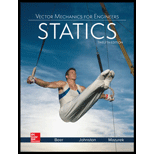
Solve Prob. 8.118 assuming that drum B is frozen and cannot rotate.
8.118 Bucket A and block C are connected by a cable that passes over drum B. Knowing that drum B rotates slowly counterclockwise and that the coefficients of friction at all surfaces are μS = 0.35 and μk = 0.25, determine the smallest combined mass m of the bucket and its content for which block C will (a) remain at rest, (b) start moving up the incline, (c) continue moving up the incline at a constant speed.

Fig. P8.118
(a)
Find the smallest combined mass m of the bucket for the block C will remain at rest.
Answer to Problem 8.119P
The smallest combined mass m of the bucket is
Explanation of Solution
Given information:
The mass of the block C is
The coefficient of static friction is
The coefficient of kinetic friction is
The drum B is frozen and cannot rotate.
Calculation:
Show the free-body diagram of the drum B as in Figure 1.
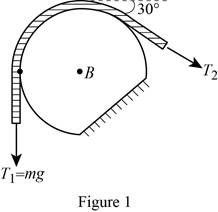
Find the angle of the belt wounded around the drum as follows;
Find the tension
Substitute mg for
Here, the acceleration due to gravity is g.
Consider the value of acceleration due to gravity is
Show the free-body diagram of the block C as in Figure 2.
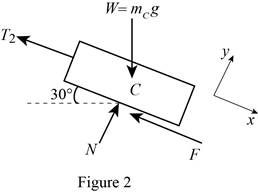
At rest, the cable slips on the drum. The motion impending is along the x-axis.
Substitute
Resolve the horizontal component of forces.
Substitute 100 kg for
Find the friction force (F) using the relation.
Substitute 0.35 for
Resolve the vertical component of forces.
Substitute
Therefore, the smallest combined mass m of the bucket is
(b)
Find the smallest combined mass m of the bucket for the block C start moving up the incline.
Answer to Problem 8.119P
The smallest combined mass m of the bucket is
Explanation of Solution
Given information:
The mass of the block C is
The coefficient of static friction is
The coefficient of kinetic friction is
The drum B is frozen and cannot rotate.
Calculation:
Show the free-body diagram of the drum B as in Figure 3.
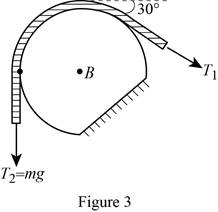
Find the angle of the belt wounded around the drum as follows;
Find the tension
Substitute mg for
Show the free-body diagram of the block C as in Figure 4.

When the block start moving up the incline;
No slipping occurs at block and drum. The motion impending is against the x-axis.
Substitute
Resolve the horizontal component of forces.
Substitute 100 kg for
Find the friction force (F) using the relation.
Substitute 0.35 for
Resolve the vertical component of forces.
Substitute
Therefore, the smallest combined mass m of the bucket is
(c)
Find the smallest combined mass m of the bucket for the block C continue moving up the incline at constant speed.
Answer to Problem 8.119P
The smallest combined mass m of the bucket is
Explanation of Solution
Given information:
The mass of the block C is
The coefficient of static friction is
The coefficient of kinetic friction is
The drum B is frozen and cannot rotate.
Calculation:
Show the free-body diagram of the drum B as in Figure 5.
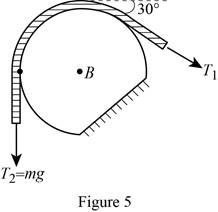
Find the angle of the belt wounded around the drum as follows;
Find the tension
Substitute mg for
Show the free-body diagram of the block C as in Figure 6.
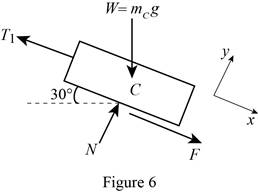
When the block start moving up the incline;
No slipping occurs at block and drum. The motion impending is against the x-axis.
Substitute
Resolve the horizontal component of forces.
Substitute 100 kg for
Find the friction force (F) using the relation.
Substitute 0.25 for
Resolve the vertical component of forces.
Substitute
Therefore, the smallest combined mass m of the bucket is
Want to see more full solutions like this?
Chapter 8 Solutions
Vector Mechanics for Engineers: Statics
- A rope having a weight per unit length of 0.4 lb/ft is wound 2 1/2 Times around a horizontal rod. Knowing that the coefficient of static friction between the rope and the rod is 0.30, determine the minimum length x of rope that should be left hanging if a 100-lb load is to be supported.arrow_forwardThree packages each of weight m = 9 kg A, B, and C are placed on a conveyor belt that is at rest. Between the belt and both packages A and C, the coefficients of friction are Ms = 0.30 and Mk = 0.20; between package B and the belt, the coefficients are Ms = 0.10 and Mk = 0.08. The packages are placed on the belt so that they are in contact with each other and at rest. Determine which, if any, of the packages will move and the friction force acting on each package. The frictional force acting on A is N The frictional force acting on B is N The frictional force acting on C is N Note: please show correct step by step working out. And double check final answers. Also for frictional force A, B & C show their directions as well. Thanks!arrow_forwardTwo 8-kg blocks A and B resting on shelves are connected by a rod of negligible mass. Knowing that the magnitude of a horizontal force P applied at C is slowly increased from zero, determine the value of P for which motion occurs and what that motion is when the coefficient of static friction between all surfaces is (a) μs= 0.40, (b) μs= 0.50.arrow_forward
- Solve Prob. 8.13 assuming that package B is placed to the right of both packages A and C.(Reference to Problem 8.13):Three 4-kg packages A, B, and C are placed on a conveyor belt that is at rest. Between the belt and both packages A and C the coefficients of friction are μs= 0.30 and μk= 0.20; between package B and the belt, the coefficients are μs= 0.10 and μk= 0.08. The packages are placed on the belt so that they are in contact with each other and at rest. Determine which, if any, of the packages will move and the friction force acting on each package.arrow_forwardSITUATION 2: A packing crate of mass 40 kg is pulled by a rope as shown. Knowing that the coefficient of static friction between the crate and the floor is 0.35, answer the following questions: 4. If α = 40°, determine the magnitude of the force P required to move the crate, in N. (ANSWER: 139) 5. If the crate must be moved to the left along the floor without tipping, determine the largest allowable value of α in degrees. (ANSWER: 58)arrow_forward9. Knowing that the coefficient of friction between the 15-kg block and the incline is us 0.25, determine (a) the smallest value of P required to maintain the block in equilibrium, (b) the corresponding value of ß. (P=108.8 N, ß=46º) 15 kg 60°arrow_forward
- An 8400-kg truck is traveling on a level horizontal curve, resulting in an effective lateral force H (applied at the center of gravity G of the truck).Treating the truck as a rigid system with the center of gravity shown, andknowing that the distance between the outer edges of the tires is 1.8 m,determine (a) the maximum force H before tipping of the truck occurs,(b) the minimum coefficient of static friction between the tires and roadwaysuch that slipping does not occur before tipping.arrow_forwardA recording tape passes over the 20-mm-radius drive drum B and under the idler drum C . Knowing that the coefficients of friction between the tape and the drums are μs= 0.40 and μk= 0.30 and that drum C is free to rotate, determine the smallest allowable value of P if slipping of the tape on drum B is not to occur.arrow_forwardKnowing that the coefficient of static friction between the tires and the road is 0.8 for the automobile (m=1130 kg) shown, determine ▼0,5 m 1.5 m 1 m normal reaction at front wheels (N), the car is assumed front wheel drive. normal reaction at rear wheels (N), the car is assumed front wheel drive. maximum acceleration (m/s²), the car is assumed front wheel drive. normal reaction at front wheel (N), the car is assumed rear wheel drive. normal reaction at rear wheel (N), the car is assumed rear wheel drive. maximum acceleration (m/s²), the car is assumed rear wheel drive.arrow_forward
- Ex.4 The coefficients of static and kinetic friction between the 100-kg block and the inclined plane are 0.30 and 0.20, respectively. Determine (a) the friction force F acting on the block when P is applied with a magnitude of 200 N to the block at rest, (b) the force P required to initiate motion up the incline from rest, and (c) the friction force F acting on the block if P = 600 N. 100 kg 200 H, = 0.30 HA = 0.20 15° LEC.4 FRICTIONarrow_forwardQ2) A loaded Porter governor has four links each 200 mm long and are hinged at a distance of 40 mm from the axis of rotation. The mass of each ball is 2 kg and mass of the sleeve is 20 kg. The governor sleeve begins to rise at 300 r.p.m. when the links are at an angle of 35° to the vertical. Assuming the friction force to be constant, determine the minimum and maximum speed of rotation when the inclination of the arms to the vertical is 40°.arrow_forwardPROBLEM 8.29 5 ft The 50-lb plate ABCD is attached at A and D to collars that can slide on the vertical rod. Knowing that the coefficient of static friction is А 0.40 between both collars and the rod, determine whether the plate is 2 ft in equilibrium in the position shown when the magnitude of the B vertical force applied at E is (a) P=0, (b) P=20 lb. E • G 50 lb 3 ftarrow_forward
 Elements Of ElectromagneticsMechanical EngineeringISBN:9780190698614Author:Sadiku, Matthew N. O.Publisher:Oxford University Press
Elements Of ElectromagneticsMechanical EngineeringISBN:9780190698614Author:Sadiku, Matthew N. O.Publisher:Oxford University Press Mechanics of Materials (10th Edition)Mechanical EngineeringISBN:9780134319650Author:Russell C. HibbelerPublisher:PEARSON
Mechanics of Materials (10th Edition)Mechanical EngineeringISBN:9780134319650Author:Russell C. HibbelerPublisher:PEARSON Thermodynamics: An Engineering ApproachMechanical EngineeringISBN:9781259822674Author:Yunus A. Cengel Dr., Michael A. BolesPublisher:McGraw-Hill Education
Thermodynamics: An Engineering ApproachMechanical EngineeringISBN:9781259822674Author:Yunus A. Cengel Dr., Michael A. BolesPublisher:McGraw-Hill Education Control Systems EngineeringMechanical EngineeringISBN:9781118170519Author:Norman S. NisePublisher:WILEY
Control Systems EngineeringMechanical EngineeringISBN:9781118170519Author:Norman S. NisePublisher:WILEY Mechanics of Materials (MindTap Course List)Mechanical EngineeringISBN:9781337093347Author:Barry J. Goodno, James M. GerePublisher:Cengage Learning
Mechanics of Materials (MindTap Course List)Mechanical EngineeringISBN:9781337093347Author:Barry J. Goodno, James M. GerePublisher:Cengage Learning Engineering Mechanics: StaticsMechanical EngineeringISBN:9781118807330Author:James L. Meriam, L. G. Kraige, J. N. BoltonPublisher:WILEY
Engineering Mechanics: StaticsMechanical EngineeringISBN:9781118807330Author:James L. Meriam, L. G. Kraige, J. N. BoltonPublisher:WILEY





